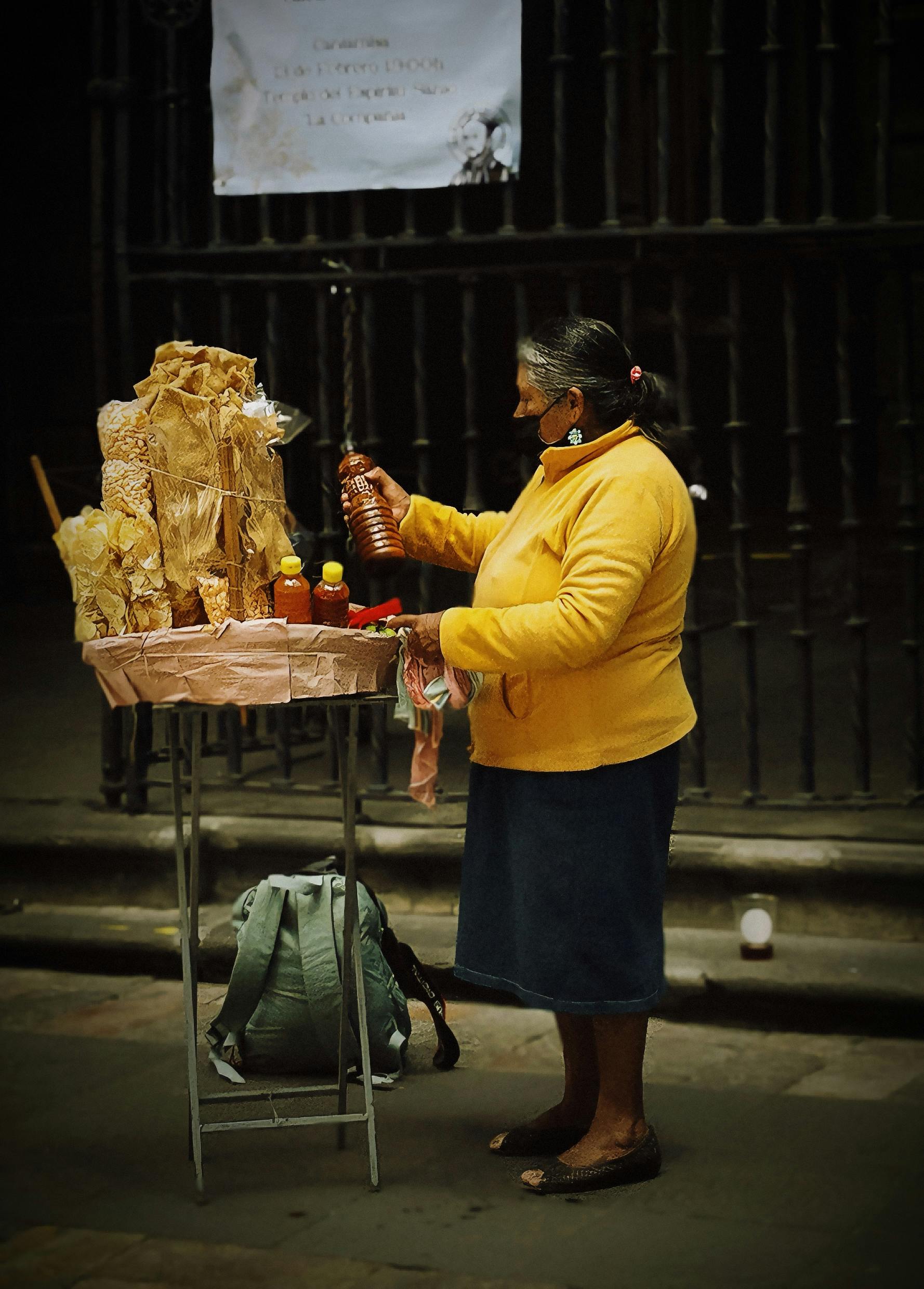Mexico Street Food Guide: Authentic Recipes & Cultural Stories
The aroma hit me first—charred corn mixing with lime and chili powder, creating this incredible sensory explosion that made my stomach growl immediately. I was standing in Mexico City’s Mercado de San Juan, completely overwhelmed by the incredible diversity of street food surrounding me. Honestly, I had no idea where to start. Every vendor seemed to be offering something more tempting than the last.
What struck me most about Mexican street food isn’t just the flavors—though they’re absolutely incredible—it’s the deep cultural heritage behind every single dish. These aren’t just quick snacks; they’re centuries-old traditions passed down through generations of families who’ve perfected their craft. Having spent considerable time exploring Mexico’s food culture, I’ve learned that understanding street food means understanding the soul of Mexican cuisine itself.
The Cultural Heart of Mexican Street Food
Mexican street food—or “antojitos” as they’re properly called—represents something much deeper than convenient dining. According to food historians at Universidad Nacional Autónoma de México, street food culture dates back to pre-Columbian civilizations, where Aztec markets offered portable meals to traders and travelers. What really gets me excited is how these ancient traditions have evolved while maintaining their authentic character.
“Street food is the DNA of Mexican cuisine. It’s where innovation meets tradition, where mothers pass secrets to daughters, and where every region tells its story through flavor.” – Chef Enrique Olvera, renowned Mexican culinary expert
I’ve always found it fascinating how Mexican street food perfectly balances convenience with complexity. These aren’t simplified versions of restaurant dishes—they’re often more intricate and flavorful than anything you’ll find in upscale establishments. The vendors I’ve met take incredible pride in their craft, some using family recipes that haven’t changed for generations.
Mexico Food Culture Fact
Mexico has over 500,000 registered street food vendors nationwide, generating approximately $20 billion annually. UNESCO recognized traditional Mexican cuisine as an Intangible Cultural Heritage of Humanity in 2010, specifically highlighting street food’s role in preserving culinary traditions and community identity.
What I love most about exploring Mexican street food is how it connects you directly to local communities. Every neighborhood has its own specialties, its own preferred vendors, its own unique takes on classic dishes. It’s like having a delicious roadmap to understanding Mexican culture, one bite at a time.
Essential Mexican Street Food Dishes You Need to Try
Alright, let’s dive into the dishes that absolutely define Mexican street food culture. I’m going to be honest—picking favorites here is like choosing between children, but these are the ones that consistently blow my mind and represent the incredible diversity of Mexican cuisine.
Tacos: Beyond Your Wildest Expectations
Forget everything you think you know about tacos. Real Mexican street tacos are small, served on soft corn tortillas, and packed with flavors that’ll make you question every taco you’ve ever eaten before. During my time in Oaxaca, I watched a taquero prepare al pastor tacos, and honestly, it was like watching performance art.
Authentic Taco Varieties to Seek Out
- Tacos al Pastor: Marinated pork cooked on vertical spits, inspired by Lebanese immigrants
- Carnitas: Slow-cooked pork that’s crispy outside, tender inside
- Barbacoa: Traditionally lamb or goat, slow-cooked underground
- Pescado: Fresh fish tacos, especially popular in coastal regions
| Taco Type | Primary Protein | Cooking Method | Best Regions |
|---|---|---|---|
| Al Pastor | Marinated Pork | Vertical Spit | Mexico City, Puebla |
| Carnitas | Pork Shoulder | Slow Braised | Michoacán, Central Mexico |
| Cochinita Pibil | Achiote Pork | Banana Leaf Wrapped | Yucatán Peninsula |
Elote: Mexican Street Corn Perfection
I’ll never forget my first proper elote experience. Street vendor in Guadalajara, massive smile, and this incredible corn creation that looked almost too beautiful to eat. Mexican street corn isn’t just corn—it’s a complete flavor experience that balances sweet, salty, tangy, and spicy in ways that shouldn’t work but absolutely do.
What makes elote so special is the layering of flavors and textures. According to research from the Centro de Investigación y de Estudios Avanzados, traditional elote preparation involves specific techniques that maximize both nutritional value and flavor complexity. The corn is typically grilled over charcoal, giving it this incredible smoky sweetness that forms the foundation for everything else.
Classic Elote Preparation Method
- Grill corn over medium-high heat until charred and tender
- Insert wooden stick for handling
- Brush with Mexican crema or mayonnaise
- Roll in cotija cheese or queso fresco
- Dust with chili powder (tajín is popular)
- Finish with fresh lime juice
Tamales: Ancient Comfort Food
Tamales represent one of Mexico’s oldest food traditions, and honestly, they’re still one of the most ingenious portable meals ever created. The masa dough steamed in corn husks creates this incredible texture that’s simultaneously comforting and sophisticated. I’ve been trying to perfect my tamale-making technique for years, and I’m still learning new tricks from abuelitas who make it look effortless.
“Making tamales is meditation. It’s community. It’s love wrapped in corn husks and shared with family. You cannot rush this process—the masa knows when you’re impatient.” – Maria Gonzalez, traditional tamale maker from Michoacán
What I find most impressive about tamales is their incredible regional diversity. Sweet tamales with raisins and cinnamon from Central Mexico, spicy tamales oaxaqueños wrapped in banana leaves, seafood tamales from coastal regions—each area has developed its own distinct traditions and flavor profiles.

Regional Variations: A Delicious Journey Through Mexico
Here’s where Mexican street food gets really exciting—and honestly, a bit overwhelming in the best possible way. Every state, every city, sometimes every neighborhood has its own specialties that reflect local ingredients, cultural influences, and centuries of culinary evolution. I’ve spent years exploring these regional differences, and I’m still discovering new favorites regularly.
Yucatán Peninsula: Mayan-Influenced Flavors
The Yucatán’s street food scene absolutely blew my mind when I first experienced it. The Mayan influence creates flavor combinations you won’t find anywhere else in Mexico. Cochinita pibil—pork marinated in achiote and citrus, then wrapped in banana leaves—represents this region’s genius for balancing indigenous techniques with colonial influences.
What really gets me excited about Yucatecan cuisine is how it maintains authentic Mayan cooking methods. According to anthropological studies from Universidad Autónoma de Yucatán, many street food preparations still use pre-Columbian techniques, including underground pit cooking and specific spice combinations that haven’t changed for centuries.
Must-Try Yucatecan Street Foods
- Sopa de Lima: Tangy lime soup with crispy tortilla strips
- Panuchos: Fried tortillas stuffed with black beans and topped with turkey
- Marquesitas: Crispy crepes filled with cheese and sweet toppings
- Elote Preparado: Local corn variety with specific regional toppings
Oaxaca: The Culinary Capital
If I had to choose one region that perfectly represents Mexican street food complexity, it’d be Oaxaca. The indigenous Zapotec and Mixtec influences create incredibly sophisticated flavor profiles that honestly make me emotional every time I eat them. Plus, this is mole country—and Oaxacan street vendors serve mole preparations that would make fancy restaurants jealous.
I’ll never forget watching a vendor in Oaxaca City’s Mercado 20 de Noviembre prepare chapulines—seasoned grasshoppers that are actually incredibly delicious once you get past the initial psychological barrier. The vendor noticed my hesitation and laughed, explaining that these provide excellent protein and have been eaten locally for over 500 years.
| Region | Signature Dish | Key Ingredients | Cultural Influence |
|---|---|---|---|
| Oaxaca | Tlayudas | Large tortillas, beans, cheese | Zapotec |
| Veracruz | Pescado a la Veracruzana | Fresh fish, tomatoes, olives | Spanish Colonial |
| Jalisco | Tortas Ahogadas | Crusty bread, spicy sauce | European-Mexican |
| Baja California | Fish Tacos | Fresh fish, cabbage, cream | Coastal-International |
Mastering Authentic Cooking Techniques
Now, here’s where things get really interesting—and where I’ve made plenty of mistakes over the years. Authentic Mexican street food isn’t just about ingredients; it’s about specific techniques that have been refined over generations. I used to think I could shortcut these methods, but honestly, that never works out well.
The Art of Masa Preparation
Masa—corn dough—forms the foundation of so many Mexican street foods, and getting it right makes all the difference. I learned this lesson the hard way when my early tamale attempts turned out dense and flavorless. The problem wasn’t my fillings; it was my masa technique.
Traditional masa preparation involves nixtamalization—a process where dried corn is treated with lime (cal) to improve nutritional value and create the proper texture. According to research from the International Maize and Wheat Improvement Center, this ancient technique increases calcium content by 750% and makes essential amino acids more bioavailable.
“Good masa talks to you. It tells you when it needs more liquid, when it’s been mixed enough, when it’s ready to become something beautiful. You must listen with your hands, not just your eyes.” – Carmen Rodriguez, third-generation masa specialist from Puebla
Essential Masa Tips for Home Cooks
- Use masa harina specifically labeled for tamales or tortillas
- Gradually add warm liquid while mixing to prevent lumps
- Beat masa until it passes the float test (small ball floats in water)
- Season masa itself—don’t rely only on filling flavors
- Let masa rest 30 minutes before using for best texture
What I’ve learned through trial and error—lots of error, honestly—is that masa preparation requires patience and attention. You can’t rush it, and you definitely can’t multitask while mixing. The texture changes are subtle but crucial, and developing that tactile sense takes practice.
Food Safety and Dietary Adaptations
Let’s talk about something super important that often gets overlooked when people discuss street food—safety and dietary considerations. I’ve learned this stuff the hard way through some, uh, unfortunate experiences early in my Mexican food adventures. But honestly, with proper knowledge and precautions, you can safely enjoy incredible street food experiences.
Smart Street Food Safety Practices
The key to safe street food enjoyment is observation and common sense. According to research from the Pan American Health Organization, properly managed street food vendors actually maintain excellent safety standards, often exceeding those of conventional restaurants. What matters is knowing what to look for.
Street Food Safety Checklist
- Choose vendors with high turnover—fresh ingredients matter
- Watch for proper food handling and clean preparation areas
- Ensure hot foods are served hot, cold foods stay cold
- Trust your instincts—if something seems off, skip it
- Start gradually if you’re not used to spicy foods
I’ve found that asking locals for recommendations works incredibly well. They know which vendors maintain consistently high standards and which ones to avoid. Plus, many vendors take pride in their reputation and appreciate customers who show genuine interest in their craft.
Accommodating Dietary Restrictions
Mexican street food can absolutely accommodate various dietary needs, though it requires some knowledge and communication. I’ve helped several vegetarian and gluten-sensitive friends navigate Mexican street food scenes successfully—it just takes a bit more planning and awareness.
| Dietary Need | Great Options | What to Avoid | Spanish Phrases to Know |
|---|---|---|---|
| Vegetarian | Elote, quesadillas, bean tamales | Lard-cooked beans, meat broths | “Sin carne, por favor” |
| Gluten-Free | Corn tortillas, tamales, elote | Flour tortillas, some sauces | “Sin gluten, por favor” |
| Dairy-Free | Tacos al pastor, fruit waters | Crema, queso, some mole | “Sin lácteos, por favor” |
Bringing Mexican Street Food Home
Here’s what I’ve learned after years of trying to recreate Mexican street food in my own kitchen—it’s absolutely possible, but it requires respect for authentic techniques and patience with the learning process. Some of my best cooking successes have come from embracing traditional methods rather than trying to find shortcuts.
The most important thing I can tell you is to start simple and build your skills gradually. I used to try making complex moles on my first attempts, which usually ended in disaster. Now I recommend starting with elote or simple quesadillas, then progressing to more complex dishes as your technique improves.
“Cooking Mexican food at home isn’t about perfection—it’s about connection. Connection to the culture, to the techniques, to the generations who developed these recipes. When you approach it with respect and patience, the food will teach you.” – Chef Gabriela Cámara, internationally recognized Mexican cuisine expert
Final Thoughts: More Than Just Food
Mexican street food has taught me so much more than cooking techniques. It’s shown me how food connects communities, preserves cultures, and creates shared experiences that transcend language barriers. Every vendor I’ve met has a story, every dish has history, and every bite connects you to something larger than yourself.
If you’re planning to explore Mexican street food—whether in Mexico or at home—approach it with curiosity, respect, and an empty stomach. Be patient with yourself as you learn, be open to new flavors and textures, and most importantly, enjoy the incredible journey of discovery that awaits you.
What strikes me most is how Mexican street food continues evolving while maintaining its authentic character. New vendors bring fresh perspectives, traditional techniques adapt to modern challenges, and each generation adds its own chapter to this incredible culinary story. And honestly? That’s exactly how it should be.


